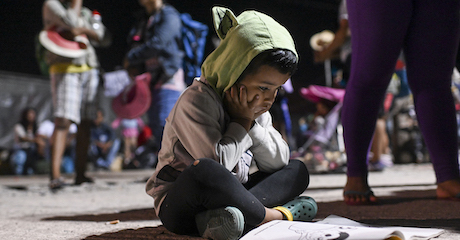Every year, tens of thousands of children travel through Mexico to the southwestern U.S. border unaccompanied by parents or caregivers. Most if not all are fleeing violence, poverty and lack of opportunity in their home countries. They come seeking safety and a better life — often with the hope of reuniting with loved ones already living and working in the U.S.
Most unaccompanied child migrants are taken into U.S. federal custody upon arrival. They remain in custody for up to three months while federal agencies seek to identify and vet any parents, relative or other adults who might be able to care for them while their immigration or asylum case is pending. During that time, they typically receive health care, counseling and other social services.
The UNICEF-MPI report is a road map for transforming systems for supporting migrant children who arrive in the U.S. unaccompanied
Yet once these children are released — once they begin their transition to their new home, new school and new community, their access to these support services typically tapers off, at great risk to their health and well-being, not only during what can be a very difficult adjustment period, but over the long term.
There are many practical challenges, language and cultural barriers, and other hurdles to overcome as they settle in and make a new life. Many child migrants have been traumatized by their experiences, and so are working through that as well.
In an effort to improve access to critical services for these vulnerable children after their release from custody — and to amplify their effectiveness — UNICEF and the Migration Policy Institute (MPI) have released a detailed report recommending key strategies for those working in this area. The goal, the coauthors say, is to provide a road map for transforming the post-release landscape.
“Reunification with a parent or other sponsor is not a single event but the start of a longer-term process that requires ongoing support,” the report’s authors note. “Taking these steps will better position unaccompanied children to thrive, and the communities they join will benefit from their skills, creativity, contributions and diverse perspectives.”
The report — entitled Four Strategies to Improve Community Services for Unaccompanied Children in the United States — cites best practices and resources for government agencies, community organizations and funders. Here are some highlights:
Strategy #1: Support the whole child: link programs, coordinate facility and agency efforts
Often, health and social services for children and adolescents are provided through what the report describes as a patchwork of local organizations whose resources and capacity vary widely, and who often lack formal mechanisms to coordinate services children may be receiving from multiple providers.
The report discusses a number of ways state and local governments and community service providers can convene key partners and build linkages across programs — emphasizing that addressing the lack of communication and coordination is an important first step toward more successful transitions for children settling in new communities.
Strategy #2: Leveraging the role of public schools
All school-age children, regardless of immigration status, have the right to a free public K-12 education in the U.S., which puts schools in a unique position to help children access a wide range of services and programs, the report points out. More must be done to leverage this position; to find ways to engage new students and their parents and caregivers; to help flag a child’s needs and provide information, guidance and connections needed to address them. Setting up a school-based “navigation services” can go along way in easing a newcomer’s transition.
Strategy #3: Use interdisciplinary approaches
The best way to help a child is holistically — rather than piecemeal.
Wide-ranging needs require expertise from many different kinds of professionals (immigration attorneys, pediatricians, mental health clinicians, case managers) who typically operate independently through different organizations, creating transportation, scheduling, coordination and other logistical challenges for children and caregivers.
The solution: design programs using an interdisciplinary approach. Offer multiple services at one location, from a team that shares information.
Strategy #4: Develop a diverse and highly skilled workforce
Organizations dedicated to serving child migrants who arrive in the U.S. unaccompanied need to have multilingual and culturally competent staff who are also trained to work with children coping with trauma.
It can be difficult to recruit and retain employees in social service fields like adolescent mental health. Turnover rates are high. The work is emotionally demanding, with heavy caseloads. The UNICEF-MPI report discusses various ways to overcome staffing challenges, by offering mentoring and financial support for certications or advanced degrees, for example, among other promising practices.
For more information about each of these proposed strategies, read the full report.
Child migrants from Guatemala. © UNICEF/UN0223942
A priority for UNICEF is to work with partners to help ensure that children on the move receive child-sensitive and adequate reception and care — especially children traveling unaccompanied or separated from parents and caregivers.
Learn about how UNICEF works to support and protect migrant children and families — and how what happens at the U.S. border is only a small part of a much longer, complicated story.
Help UNICEF reach more children in need. Your support can make a difference. Donate today.
Top photo credit: © Carolyn Van Houten/The Washington Post via Getty Images
